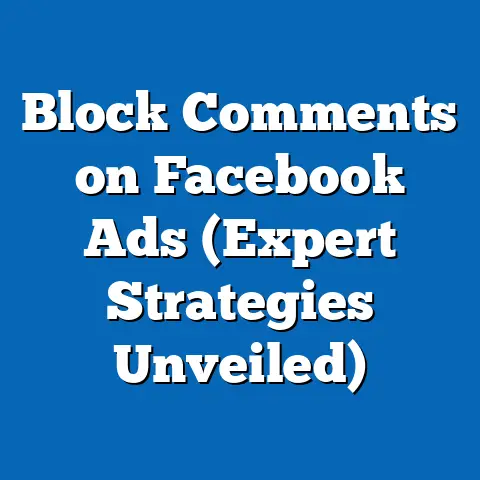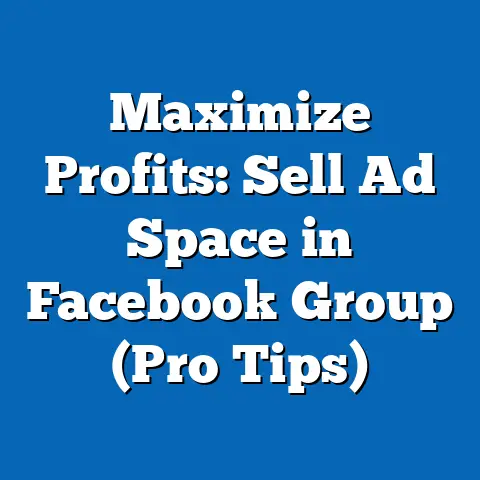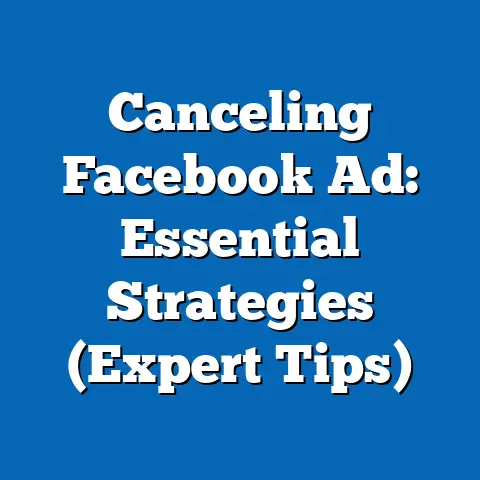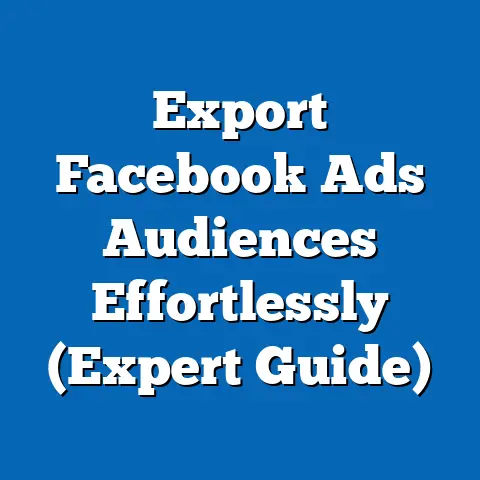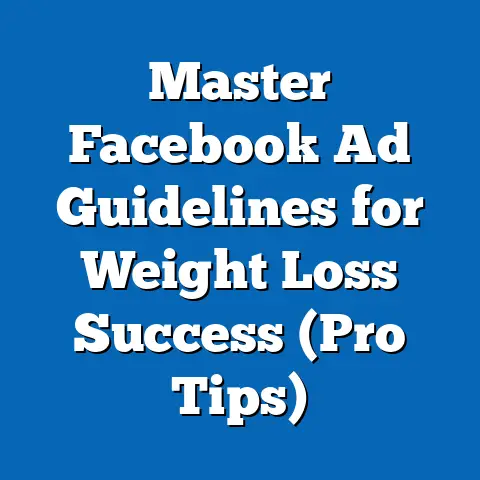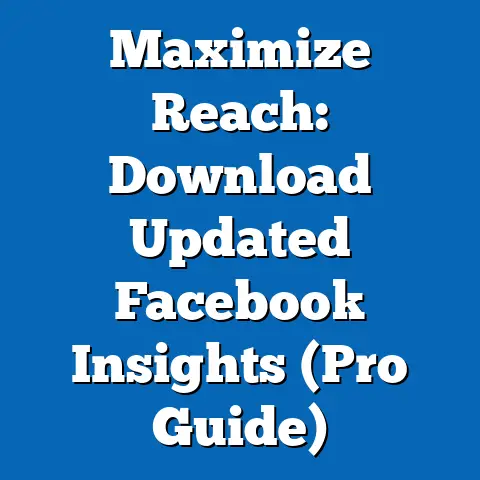Boost Campaigns with Facebook Ad Strategies (Pro Tips)
Have you ever felt like you’re shouting into a void with your Facebook ads? I know I have. It’s a frustrating experience, pouring time, money, and creative energy into campaigns that seem to disappear into the ether, yielding little to no return. I remember one particularly painful campaign I ran for a local bookstore. We had beautiful imagery, witty copy, and what I thought was a laser-focused target audience. Yet, the sales just weren’t materializing. It felt like throwing money into a black hole.
But on the flip side, I’ve also experienced the sheer exhilaration of launching a Facebook ad campaign that works. The kind that brings in a flood of leads, skyrockets sales, and creates a buzz around your brand. I’ll never forget the campaign I ran for a new organic skincare line. The ads were so effective that they sold out of their initial inventory within a week! The phone wouldn’t stop ringing, and their website traffic exploded. That’s the kind of success we all crave, and it’s absolutely achievable with the right Facebook ad strategies.
In today’s digital marketing world, Facebook ads are more than just a nice-to-have – they’re a necessity. With billions of active users, Facebook offers unparalleled reach and targeting capabilities. But simply creating an ad and hoping for the best just isn’t enough. To truly succeed, you need a strategic approach, a deep understanding of the platform, and a willingness to constantly test and optimize.
Understanding the Facebook Ads Landscape
Facebook ads have come a long way since their humble beginnings. Initially, they were simple text-based ads that often felt intrusive and irrelevant. But over the years, Facebook has evolved its advertising platform into a sophisticated and powerful tool for businesses of all sizes.
The Evolution of Facebook Ads:
I remember when Facebook ads were just starting out. They were basic, clunky, and often felt like an afterthought. But Facebook quickly realized the potential of its massive user base and began investing heavily in its advertising platform. They introduced new ad formats, improved targeting options, and developed sophisticated analytics tools.
Today, Facebook ads are a far cry from their early iterations. They’re now highly customizable, visually appealing, and incredibly effective when executed correctly. They’ve become an integral part of any comprehensive social media marketing strategy.
The Importance of Facebook Ads in Social Media Marketing:
In a world saturated with content, Facebook ads provide a way to cut through the noise and reach your target audience directly. Organic reach on Facebook has been steadily declining, making paid advertising a crucial component of any successful marketing campaign.
Consider these statistics:
- Over 2.9 billion people use Facebook every month. This massive user base provides unparalleled reach for your advertising campaigns.
- The average Facebook user spends nearly 20 minutes per day on the platform. This provides ample opportunity for your ads to be seen and engaged with.
- Facebook generates over $117 billion in advertising revenue annually. This demonstrates the platform’s effectiveness as an advertising channel.
- Studies show that Facebook ads can increase brand awareness by up to 80%. This highlights the power of Facebook ads in building brand recognition.
These numbers underscore the importance of Facebook ads in today’s marketing landscape. They offer a unique opportunity to connect with your target audience, build brand awareness, and drive conversions.
Exploring the Various Ad Formats:
Facebook offers a wide range of ad formats to suit different objectives and creative styles. Understanding the unique advantages of each format is crucial for creating effective campaigns. Here’s a brief overview:
- Image Ads: These are the simplest and most common type of Facebook ad. They consist of a single image, headline, and description. Image ads are great for driving traffic to your website or promoting a specific product.
- Video Ads: Video ads are highly engaging and can be used to tell a story, showcase your product, or provide valuable information. They’re particularly effective for building brand awareness and driving conversions.
- Carousel Ads: Carousel ads allow you to showcase multiple images or videos in a single ad unit. This format is ideal for highlighting different features of a product or telling a sequential story.
- Slideshow Ads: Slideshow ads combine multiple images into a video-like format. They’re a cost-effective alternative to video ads and can be used to create visually appealing and engaging content.
- Collection Ads: Collection ads are designed for e-commerce businesses. They allow you to showcase a collection of products in a visually appealing format, making it easy for users to browse and purchase directly from the ad.
- Lead Ads: Lead ads are designed to generate leads directly on Facebook. They allow users to submit their contact information without leaving the platform, making it easy for you to capture leads and build your email list.
Takeaway: Facebook advertising is a dynamic and powerful tool that can significantly impact your business growth. Understanding the platform’s evolution, recognizing its importance in social media marketing, and exploring the various ad formats available are essential first steps towards crafting a winning Facebook ad strategy.
Crafting a Winning Facebook Ad Strategy
Creating a successful Facebook ad campaign requires more than just a visually appealing ad. It demands a well-defined strategy that aligns with your business goals, targets the right audience, and optimizes your budget for maximum impact.
Defining Your Goals:
Before you even think about creating an ad, you need to clearly define your goals. What do you want to achieve with your Facebook ad campaign? Are you looking to:
- Increase Brand Awareness? If so, your focus should be on reaching a broad audience and creating visually appealing content that resonates with your brand.
- Generate Leads? In this case, you’ll want to use lead ads or drive traffic to a landing page where users can submit their contact information.
- Drive Website Traffic? Focus on creating compelling ads that entice users to click through to your website.
- Increase Sales? Use collection ads or showcase your products in engaging video ads.
- Promote an Event? Create event ads that highlight the key details of your event and encourage users to RSVP.
I’ve seen countless businesses waste money on Facebook ads simply because they didn’t have a clear objective in mind. They created generic ads that didn’t resonate with anyone, and unsurprisingly, they didn’t see any results.
Identifying Your Target Audience:
One of the most powerful features of Facebook advertising is its sophisticated targeting capabilities. You can target users based on demographics, interests, behaviors, and more.
Here are some key targeting options to consider:
- Demographics: Target users based on age, gender, location, education, and other demographic factors.
- Interests: Target users based on their interests and hobbies, such as sports, music, movies, and more.
- Behaviors: Target users based on their online behavior, such as purchase history, website visits, and app usage.
- Custom Audiences: Create custom audiences by uploading your customer list or targeting users who have interacted with your website or app.
- Lookalike Audiences: Expand your reach by creating lookalike audiences based on your existing customers or website visitors. Facebook will identify users who share similar characteristics and interests as your target audience.
I once worked with a local bakery that was struggling to attract new customers. After analyzing their customer data, we discovered that their ideal customer was a woman aged 25-45 who was interested in baking, healthy eating, and local businesses. We created a Facebook ad campaign targeting this specific audience, and the results were phenomenal. Their website traffic increased by 50%, and their sales skyrocketed.
Budgeting and Bidding Strategies:
Determining the right budget for your Facebook ad campaign can be tricky. There’s no one-size-fits-all answer, as it depends on your goals, target audience, and industry.
Here are some factors to consider when setting your budget:
- Daily vs. Lifetime Budget: Choose between setting a daily budget or a lifetime budget for your campaign. A daily budget allows you to control how much you spend each day, while a lifetime budget allows you to set a total budget for the entire duration of your campaign.
- Bidding Strategies: Facebook offers several bidding strategies to choose from, including CPC (cost-per-click), CPM (cost-per-impression), and CPA (cost-per-acquisition). The best bidding strategy for you will depend on your goals and budget.
- Campaign Duration: Consider the duration of your campaign when setting your budget. A longer campaign will require a larger budget than a shorter campaign.
I’ve learned that it’s often better to start with a smaller budget and gradually increase it as you see results. This allows you to test different targeting options and ad creatives without breaking the bank.
Takeaway: Crafting a winning Facebook ad strategy involves defining your goals, identifying your target audience, and optimizing your budget for maximum impact. By carefully considering these factors, you can create campaigns that deliver real results and drive business growth.
Creating Compelling Ad Content
Even with a perfectly targeted audience and a well-defined strategy, your Facebook ad campaign will fall flat if your ad content isn’t compelling. Your ad needs to grab attention, communicate your message clearly, and entice users to take action.
The Power of Effective Ad Copywriting:
The words you use in your ad are just as important as the visuals. Your headline, body text, and call-to-action (CTA) need to work together to create a compelling message that resonates with your target audience.
Here are some tips for writing effective ad copy:
- Keep it concise: Get straight to the point and avoid using jargon or technical terms.
- Highlight the benefits: Focus on the benefits of your product or service, rather than just the features.
- Use strong verbs: Use action verbs that create a sense of urgency and excitement.
- Personalize your message: Use language that speaks directly to your target audience.
- Include a clear call-to-action: Tell users exactly what you want them to do, whether it’s to visit your website, make a purchase, or sign up for your email list.
I once worked with a client who was struggling to generate leads with their Facebook ads. After reviewing their ad copy, I realized that it was too generic and didn’t highlight the unique benefits of their product. We rewrote the ad copy to focus on the specific pain points of their target audience and emphasize how their product could solve those problems. The results were dramatic. Their lead generation increased by over 200%.
The Significance of Visual Elements:
In the visually driven world of social media, your ad’s visual elements are crucial for capturing attention and driving engagement. Your images and videos need to be high-quality, relevant, and visually appealing.
Here are some tips for creating effective visual elements:
- Use high-quality images and videos: Avoid using blurry or pixelated images.
- Choose images and videos that are relevant to your message: Make sure your visuals align with your ad copy and target audience.
- Use bright colors and eye-catching designs: Grab attention with visually appealing designs that stand out from the crowd.
- Test different visuals: Experiment with different images and videos to see what resonates best with your audience.
I’ve found that using images of real people, rather than stock photos, can significantly improve ad performance. People are more likely to connect with ads that feature authentic imagery.
Examples of Successful Ads:
Let’s take a look at some examples of successful Facebook ads and analyze what makes them effective:
- Example 1: A skincare company using a video ad showcasing the transformation of a customer’s skin after using their product. This ad is effective because it uses a visually compelling video to demonstrate the product’s benefits. The video features a real customer, which adds authenticity and credibility.
- Example 2: A clothing retailer using a carousel ad to showcase their latest collection. This ad is effective because it allows users to browse multiple products in a single ad unit. The images are high-quality and visually appealing, and the ad copy highlights the key features of each product.
- Example 3: A local restaurant using an image ad to promote a special offer. This ad is effective because it uses a mouth-watering image of their food and a clear call-to-action to encourage users to visit their restaurant.
Takeaway: Creating compelling ad content is essential for driving engagement and achieving your Facebook advertising goals. By focusing on effective ad copywriting, using high-quality visual elements, and learning from successful ad examples, you can create ads that resonate with your target audience and deliver real results.
A/B Testing and Optimization
No matter how well you plan your Facebook ad campaign, there’s always room for improvement. A/B testing and optimization are crucial for refining your ads and maximizing their effectiveness.
Understanding A/B Testing:
A/B testing, also known as split testing, involves creating two or more versions of an ad and testing them against each other to see which performs best. You can A/B test different elements of your ad, such as the headline, body text, image, or call-to-action.
I always tell my clients that A/B testing is the secret weapon of successful Facebook advertisers. It allows you to make data-driven decisions and continuously improve your campaigns.
Setting Up A/B Tests:
Setting up A/B tests on Facebook is relatively straightforward. You can use Facebook’s built-in A/B testing tool or use a third-party tool.
Here’s how to set up an A/B test on Facebook:
- Create two or more versions of your ad.
- Define your testing variable. What element of your ad do you want to test?
- Set your budget and duration. How much money do you want to spend on the test, and how long do you want it to run?
- Analyze the results. Once the test is complete, analyze the results to see which version of your ad performed best.
Interpreting the Results:
Interpreting the results of your A/B tests is crucial for making informed decisions about your ad campaigns. You’ll want to look at metrics such as:
- Click-Through Rate (CTR): The percentage of people who saw your ad and clicked on it.
- Conversion Rate: The percentage of people who clicked on your ad and completed a desired action, such as making a purchase or signing up for your email list.
- Cost Per Click (CPC): The average cost you pay each time someone clicks on your ad.
- Cost Per Acquisition (CPA): The average cost you pay each time someone completes a desired action.
If one version of your ad has a significantly higher CTR or conversion rate, it’s likely the winner. However, it’s important to consider the statistical significance of your results. A small difference in performance may not be statistically significant, meaning it could be due to chance.
Pro Tips for Optimization:
Here are some pro tips for optimizing your Facebook ad campaigns:
- Test one variable at a time. This will help you isolate the impact of each variable.
- Focus on the most important metrics. Don’t get bogged down in vanity metrics. Focus on the metrics that directly impact your business goals.
- Continuously test and optimize. A/B testing is an ongoing process. Don’t stop testing after you find a winning ad.
I once ran an A/B test on a Facebook ad campaign for a local gym. We tested two different headlines: “Get in Shape This Summer” and “Transform Your Body in 8 Weeks.” The “Transform Your Body in 8 Weeks” headline performed significantly better, resulting in a 30% increase in lead generation. This simple change made a huge difference in the overall performance of the campaign.
Takeaway: A/B testing and optimization are essential for maximizing the effectiveness of your Facebook ad campaigns. By continuously testing different elements of your ads and analyzing the results, you can make data-driven decisions that improve performance and drive business growth.
Retargeting and Remarketing Strategies
Retargeting and remarketing are powerful strategies for reaching users who have already interacted with your brand. These users are more likely to convert than cold traffic, making retargeting and remarketing a cost-effective way to drive sales and generate leads.
Understanding Retargeting:
Retargeting involves showing ads to users who have visited your website, viewed a product, or engaged with your content on Facebook. The goal is to remind these users about your brand and encourage them to take action.
I often describe retargeting as the “second chance” of Facebook advertising. It allows you to reconnect with users who may have initially shown interest in your brand but didn’t convert.
The Importance of Nurturing Leads:
Users who have interacted with your brand previously are more likely to convert than cold traffic. They’re already familiar with your brand and have shown some level of interest in your products or services.
Retargeting allows you to nurture these leads and guide them further down the sales funnel. By showing them tailored ads that address their specific interests and needs, you can increase their likelihood of converting.
Implementing Retargeting Campaigns:
Here are some strategies for implementing effective retargeting campaigns:
- Use Dynamic Ads: Dynamic ads automatically show users the products they viewed on your website. This is a highly effective way to remind users about the products they were interested in and encourage them to make a purchase.
- Create Custom Audiences: Create custom audiences based on specific actions users have taken on your website or app. For example, you can create a custom audience of users who have viewed a specific product category or added an item to their cart but didn’t complete the purchase.
- Tailor Your Ad Copy: Use ad copy that speaks directly to the user’s previous interactions with your brand. For example, if a user viewed a specific product on your website, your ad copy could say, “Still thinking about that [product name]? Get it now and enjoy free shipping!”
I once worked with an e-commerce client who was struggling with abandoned carts. We implemented a retargeting campaign that showed users the products they had added to their cart but didn’t purchase. The ad copy reminded them about the items they had left behind and offered a discount code to encourage them to complete the purchase. The results were remarkable. Their abandoned cart recovery rate increased by over 40%.
Takeaway: Retargeting and remarketing are powerful strategies for nurturing leads and driving conversions. By targeting users who have already interacted with your brand, you can increase their likelihood of converting and maximize your advertising ROI.
Leveraging Facebook’s Advanced Features
Facebook offers a range of advanced features that can help you take your advertising campaigns to the next level. These features include the Facebook Pixel, Facebook Shops, lead ads, and collection ads.
The Power of the Facebook Pixel:
I consider the Facebook Pixel to be the foundation of any successful Facebook advertising strategy. It provides the data you need to understand how users are interacting with your website and how your ads are performing.
Exploring Other Advanced Features:
Here are some other advanced features to consider:
- Facebook Shops: Facebook Shops allows you to create a virtual storefront on Facebook and Instagram. This allows users to browse and purchase your products without leaving the platform.
- Lead Ads: Lead ads allow you to generate leads directly on Facebook. They make it easy for users to submit their contact information without leaving the platform.
- Collection Ads: Collection ads are designed for e-commerce businesses. They allow you to showcase a collection of products in a visually appealing format, making it easy for users to browse and purchase directly from the ad.
Success Stories of Brands:
Many brands have successfully used Facebook’s advanced features to boost their campaigns. Here are a few examples:
- A clothing retailer used Facebook Shops to create a virtual storefront on Facebook and Instagram. This allowed them to reach a wider audience and increase sales.
- A local restaurant used lead ads to generate leads for their catering services. This allowed them to capture valuable customer information and follow up with potential clients.
- An e-commerce business used collection ads to showcase their latest products and drive sales. This allowed them to create a visually appealing and engaging shopping experience for their customers.
Takeaway: Facebook offers a range of advanced features that can help you take your advertising campaigns to the next level. By leveraging these features, you can track user behavior, generate leads, and drive sales.
Staying Ahead of the Curve: Trends and Future of Facebook Ads
The Facebook advertising landscape is constantly evolving. New features, trends, and technologies are emerging all the time. To stay competitive, you need to stay ahead of the curve and adapt your strategies accordingly.
Emerging Trends in the Facebook Ads Landscape:
Here are some emerging trends to watch out for:
- Augmented Reality (AR) Ads: AR ads allow users to interact with your products in a virtual environment. This can be a highly engaging and effective way to showcase your products and drive sales.
- Artificial Intelligence (AI) in Ad Targeting: AI is being used to improve ad targeting and optimize campaigns. This can help you reach the right audience with the right message at the right time.
- Video Advertising: Video advertising continues to be a dominant trend on Facebook. Users are increasingly engaging with video content, making it a powerful tool for building brand awareness and driving conversions.
Speculating on Future Developments:
It’s difficult to predict the future with certainty, but here are some potential developments to watch out for:
- Increased Personalization: Facebook is likely to continue to personalize ad experiences based on user data and behavior.
- More Emphasis on Privacy: With increasing concerns about data privacy, Facebook is likely to introduce new features and policies to protect user privacy.
- Integration with Other Platforms: Facebook is likely to continue to integrate its advertising platform with other platforms, such as Instagram and WhatsApp.
I believe that the future of Facebook advertising will be driven by personalization, privacy, and integration. Advertisers who can adapt to these changes will be well-positioned to succeed.
Takeaway: The Facebook advertising landscape is constantly evolving. By staying ahead of the curve and adapting your strategies accordingly, you can maintain a competitive edge and continue to drive results with your campaigns.
Remember the initial frustration of those campaigns that seemed to vanish without a trace? Now, imagine the opposite. Picture your Facebook ad campaigns transforming into powerful engines of growth, consistently delivering leads, sales, and customer engagement. Imagine the satisfaction of seeing your business thrive as a result of your strategic Facebook advertising efforts.
This transformation is within your reach. By implementing the strategies discussed in this guide, you can unlock the full potential of Facebook advertising and achieve unparalleled success in your business endeavors.
Don’t just read this guide and forget about it. Take action. Implement the strategies discussed. Test different approaches. Analyze your results. And most importantly, never stop learning and adapting.
The world of Facebook advertising is constantly evolving, but with a strategic mindset and a willingness to experiment, you can stay ahead of the curve and achieve your business goals.
Now, go out there and create some amazing Facebook ad campaigns! I’m excited to see what you accomplish.
I encourage you to share your experiences with Facebook ad strategies in the comments below or on social media. Let’s learn from each other and build a community of successful Facebook advertisers.

